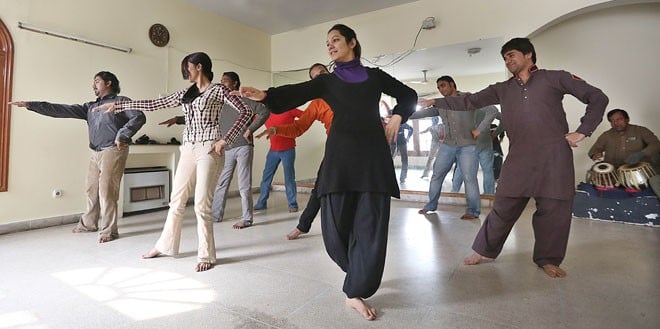

We are on the top floor of Shakir Ali Museum and at least a dozen men and women are practising Sufi dance. They coordinate their graceful yet passionate moves, hands moving from left to right in unison as they kneel, the girls at the back twirl slowly. Everyone gradually moves forward, where they stop their movements suddenly to give the show a dramatic stop.
Between the good old Kalma Chowk (the sculptured Kalma has been replaced by a flyover) and the Barkat Market is the glorious Shakir Ali Museum. And, it is a little known fact that the National Performing Arts Group (NPAG) uses the museum for practice during daytime.
The NPAG was established on May 4, 2006. It is a subsidiary of PNCA in Lahore, Islamabad and Karachi. PNCA comes under the federal Ministry of Information & National Heritage. It trains dancers and if they are persistent and talented, they can earn up to twenty five thousand rupees. They also get a transport allowance.
The group, consisting of 10-12 people, practise for three hours every day, from 10am to 1pm. They are required to have an ID card, at least a Matric certificate or equivalent qualification.
Previously, they were on contract basis but now they are permanent. The NPAG has wings in Karachi and Islamabad as well but the one in Lahore is the most active. They all have eight trainees -- four boys and four girls each. The volunteers don’t get paid, but when a member leaves or is unwell, they can replace him/her and kick-start their career. New volunteers are tested for their natural rhythm and flexibility.
"Right now the institute aims to enhance public awareness about dance as an art form," says Amna Pataudi, the director of the institute. "We teach the full history of dance, which starts from Harappa/ Mohenjodaro, if you know about the statue of the dancing girl. The journey continues to Sufi dance, dhamal etc. But we stick to dance as an art and aza ki shayari; not as a film dance."
She adds that the institute is seeking international collaboration for performances and training. Pataudi says that the said ministry, Pervaiz Rashid and Nazir Syed are very keen on investing in music.
They are being taught by well known choreographer Roshan Ara Bokhari, former actress Zarin Panna and dance master Zafar Dilawar. The group learns six to seven dances each year and has already learnt over a hundred by now. These include the Peacock dance, dhamaal, Kathak etc.
Most of the group members have been training with the NPAG since 2006. Two of the boys give training in their own academy at night. Two take classes in schools. All the girls have modelling, acting and Lollywood dreams, along with that of dance. One has recently made her TV debut in a small role, another has modelled for TV commercials and a third has been acting on stage for a while and has also won prizes for it.
The group performs every year on August 14 and on the International Dance Day. It has represented Pakistan in other countries and even won prizes in the US, China and India, thus strengthening Pakistan’s soft image abroad. The last trip they made was to Kazakistan. They even performed to represent the sufferings of the flood victims last year.
The group has also paid tributes to legendary actresses such as Sabiha Khanum and Bahar Begum and renowned film producer Muhammad Anwar.
The NPAG says they have not received any threats so far.
"In the 1970s, we had a number of performances and tours abroad," says Master Zafar Dilawar who has worked as a dancer in Syria, Muscat, Turkey and India. "Now the film industry has collapsed and PTV has no programmes on dance. All private entertainment channels are based in Karachi. There are no dance schools, art studios or even film studios now. Our choices are restricted."
He adds that if universities and colleges open music/dance departments, the trainees will get employment and be able to train the future generations also.
The group is required to weigh themselves every three months and if the members are overweight, they get a warning. Girl students usually leave when they get married, either because the work is physically strenuous or because their in-laws don’t allow them to continue in this. It becomes difficult for some to leave their households for performances abroad. They often end up starting their own businesses or teach dance in schools and academies.
Former film actress and dancer Zarin Sulaiman aka Panna is very pleased with the growth curve of her trainees. "The older generation may have been more artistic but the new generation has a fresh style. They only need to work hard on technique."
Panna’s students include many popular actresses to whom she has given a one-on-one training for years. "In Pakistan, all actresses get training in dance but they consider it an insult to admit this fact," she says.
According to her, the only actress after Rani who has shown graceful moves is Noor.
The tea boy brings us tea -- a sugary, milky warm broth -- while Master Dilawar plays on the tabla. "Kathak now!" He calls out loud and everyone starts doing the moves one has seen Madhubala do in the epic Mughal-e-Azam.
"Mughliya now," he calls out again and the beat grows faster.
Everyone knows the steps but their energy levels and facial expressions vary. This is where some stand out and others don’t. However, the music, the rhythm and my sugary tea send me into a dream-like state. Perhaps, this is why music and dance go together and exist in every culture. What a pity we almost lost this heritage of ours!